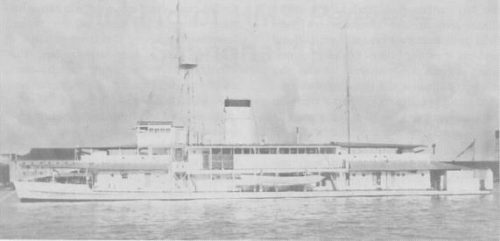- Author
- A.N. Other and NHSA Webmaster
- Subjects
- Biographies and personal histories, History - WW2
- Tags
-
- RAN Ships
- None noted.
- Publication
- December 2005 edition of the Naval Historical Review (all rights reserved)
Then occurred one of the most amazing acts of bravery I have ever seen. Almost as though it were pre-arranged by signal, sampans, those small Chinese oar-driven craft, crept out from the Shanghai shore toward the men in the water. Ignoring the heavy fire from perhaps a hundred rifles they approached the survivors. I saw one sampan reach a man and try to pull him into the boat. He was too weak. He just held on to the gunwale, and the sampan towed him in – towed him right toward shore and the shooting soldiers. I found out afterwards that it was Polkinghorn, with a piece of shell in his rump and one finger severed.
I saw one swimmer lying on his back, towing a second man who was evidently wounded. They drew the fire of the Japs. The head of the wounded man jerked several times when bullets hit. He was dead now, but his shipmate kept on swimming doggedly until a bullet hit him. His head twisted to one side and both men disappeared beneath the water.

Out in the river the Peterel was burning. The shooting had stopped and the only sound was the crackling of the flames. I thought that all of the survivors had died. I found out later that I was wrong. Her crew of 14 had one hundred percent casualties, but six of the fourteen, all wounded, somehow managed to make shore. There was nothing I could do here. ((‘Officially Dead – Story of CMDR Columbus D Smith USNR , former CO USS Wake (Wilke & Co Pty Ltd, Melbourne 1946)))
Later that day Lieut Smith was taken to the Old Mint building and imprisoned in the cellar, together with the senior Royal Navy officer in Shanghai, Commander John B. Woolley. He was furiously protesting at the lack of treatment for some of his wounded men.
The Japanese had brought Lieut Polkinghorn and the surviving members of his crew there after capture. They were in the cellar and they had had no medical attention. When an officer came in we told him we wanted to see Polkinghorn, and reluctantly he let us go down to the cellar. Polkinghorn was lying there, more dead than alive. His finger hung by a shred but the bleeding had stopped. He was suffering badly from shock. One can die from shock without having the skin broken. In the throes of shock one is very susceptible to pneumonia and the best defence is to be warmly clad. Powers of resistance are low; strength and vitality have gone. In short, you’re damn near dead.
Poor Polk lay there, his face greyish. His eyes stared at us but he did not see us. Shock had numbed his pain, and his thinking processes had come to a stop, which was merciful but dangerous. In the chill of that miserable basement he had only one light blanket over him and he was clad only in his underwear – still wet. Woolley kept muttering “God damn lousy bastards”.
The next day they were all taken to the Japanese Naval Prison in Kiangwan Road.
They had brought Polkinghorn there and he was in pitiful shape. Even worse than Polk was one of his seamen, who was suffering from second-degree burns. From the waist up his body was a mass of ugly, burnt flesh. He was in constant agony. We had no drugs. All we could do was to pile wet cloths on his body. This seemed to ease his pain. His face was so swollen that he had lost the use of his facial muscles. He couldn’t talk. It was four days before we succeeded in getting a doctor for Polk and his seaman.
Then a Jap commander arrived and, when he saw the condition of both men, he was furious. A first-rate doctor, he immediately administered opiates to them and ordered an ambulance. When the ambulance came he insisted in riding along with his patients. He wanted to treat them personally at the hospital. We learned afterwards that he had, in fact, done a magnificent job. He had amputated Polk’s finger, removed the shrapnel from his rump, and cured the burned seaman. That last was a real medical feat, for when he left the man was more dead than alive.




